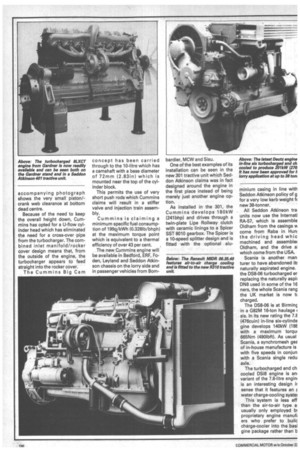Many major turbo and charge-cooled debuts
Page 105

Page 106

If you've noticed an error in this article please click here to report it so we can fix it.
Novelties abound at the Show this year — Cummins has produced an extremely compact engine, Deutz is exhibiting a turbocharged version of its naturally aspirated unit, Bedford is now 100 per cent turbocharged throughout its lorry and bus range. Graham Montgomerie picks out the plumbs
RBOCHARG1NG and chargeding are once again very ch in evidence at this year's tor Show. Scania has joined Swedish rival, Volvo, in ering nothing but turborged engines. MAN has inluced charge-cooling for its cylinder engines and Gardis rapidly expanding its turharging programme. in the gearbox front, the tle between synchromesh constant mesh is stalemate he heavy end although chro has the edge in the Idleweights. In the general re towards lighter chassis, 'eral manufacturers are pting the aluminium casing on to trim off a few kilos.
[any of the so-called "new" eline components featured he Motor Show are derives of existing units but the 'mins 10-litre engine does fit into this category as it is a n sheet of paper design.
itially the 10-litre is being red in 186kW (250bhp) form tractive units and eightelers with an alternative ratof 164kW (220bhp) for what Cummins describes as "premium 6x4 chassis."
For the city bus operator, a 134kW (180bhp) version has been produced. The engine was designed from the outset to be be turbocharged with the company having no intention of producing a naturally aspirated version.
One of the major design targets of the Cummins engineers was to produce a compact engine. While the 14-litre engine has been extremely successful for Cummins — especially in NTE 290 form — it is nevertheless a bulky and heavy engine and thus not particularly suitable for use in an eight-wheeler or a lightweight tractive unit. The 10litre weighs 850kg (1,8751b) and is only 997mm (under 40in) high.
A number of design features contribute to the low engine height including the use of a combined manifold/rocker cover and short connecting rods. The accompanying photograph shows the very small piston/crank web clearance at bottom dead centre.
Because of the need to keep the overall height down, Cummins has opted for a U-flow cylinder head which has eliminated the need for a cross-over -pipe from the turbocharger. The combined inlet manifold/rocker cover design means that, from the outside of the engine, the turbocharger appears to feed straight into the rocker cover.
The Cummins Big Cam concept has been carried through to the 10-litre which has a camshaft with a base diameter of 7 2mm (2.83in) which is mounted near the top of the cylinder block.
This permits the use of very short push rods which Cummins claims will result in a stiffer valve and injection train assembly.
Cummins is claiming a minimum specific fuel consumption of 1990(Wh (0.328Ib/bhph) at the maximum torque point which is equivalent to a thermal efficiency of over 43 per cent.
The new Cummins engine will be available in Bedford, ERF, Foden, Leyland and Seddon Atkinson chassis on the lorry side and in passenger vehicles from Born bardier, MCW and Sisu.


















































































































